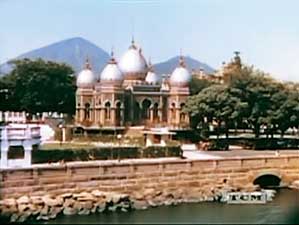
Images of the Rio of yesteryear taken from the documentary: memories now valued again
What most catches one’s eye in the Rio de Janeiro landscape that is yet to become known worldwide? The answer is as simple as it is surprising: the past. A short documentary on the city made in 1936, in Technicolor, has been drawing the attention of tens of thousands of visitors to YouTube’s free videos since September. Rio de Janeiro: city of splendor is 7 minutes and 54 seconds long. It was produced and narrated in English by American director James A. Fitzpatrick. By the third week of November, almost 120 thousand visitors had clicked onto the documentary, which was replicated in other sites and blogs.
The documentary on Rio was part of the travel films distributed by Metro Goldwyn Mayer (MGM) and known in their time as Fitzpatrick traveltalk and The voice of the globe. Normally, they showed faraway cities and places from around the world, before the main feature, and helped to close the cinema sessions at the right times. “Showing these short films, known as complements, was standard procedure in cinema sessions and a current practice of producers up to the sixties in the United States and in Brazil”, recalls Marcos Palacios, a researcher from the Federal University of Bahia’s Postgraduate Program in Contemporary Culture and Communication.
James Fitzpatrick (1894-1980) made 150 short documentaries, but he also worked as producer, director’s assistant, director, actor, script writer and especially as narrator in hundreds of other films. He was criticized for only showing the positive aspects of the places he visited. “I made my films at a time when travel was almost impossible for the average person. I believe I showed folks what they would like to have seen, had they been able to travel”, the film-maker used to answer.
Indeed, the Rio de Janeiro shown in City of splendor is almost a European city, with the added advantage of having been prettified by nature. The population was 1.5 million people. Those who appear on screen are well dressed. The streets, squares, fountains and beaches all seem to be very clean. The historical buildings, such as the Monroe Palace, later demolished, do not clash with the landscape. Everything is unbelievably harmonious. Those who see the film are charmed by a city that really did look wonderful.
Marcos Palacios sees the documentary as one of the symbols of a cultural turnaround that has not been truly noticed yet. “The Internet has leveraged memory”, he says. “The forgotten past of people and things would be lost or buried in hard-to-access archives and would be unlikely to reach us without today’s digitization and availability on networks.” The researcher states that on the Web, memory tends to become collective and permanent. The digitization process is applied to something produced in the past (films, videos, photos, texts, etc.) for current and future use.
Journalism is one of the main producers and beneficiaries of this. “For instance, The New York Times digitized its entire collection since 1851 and opened it to consultation on the Internet, indicating a worldwide trend in the written press”, he tells us. This also applies to cultural and historical icons, such as ancient Egyptian papyruses, the Nuremberg trials or the work of Leonardo da Vinci, digitized at very high resolution, as necessary, and made available in virtual form. “Additionally, digitization lets you find in a single place (a website) several formats by different authors and of different origins, enabling the construction of a multifaceted and plural memory”.
City of splendor became available to Brazilians because Marin Ottman (a German teacher of German and English in Paris) discovered Fitzpatrick’s documentary in an Internet forum specializing in cult films or films that were off the beaten track. “I put the film on YouTube to show it to friends who live in Belém”, tells us Ottman. “By the last but one week in October, City of Splendor had been seen by 150 people, but someone in Rio de Janeiro found it and since then many other people have watched it.”
Republish
